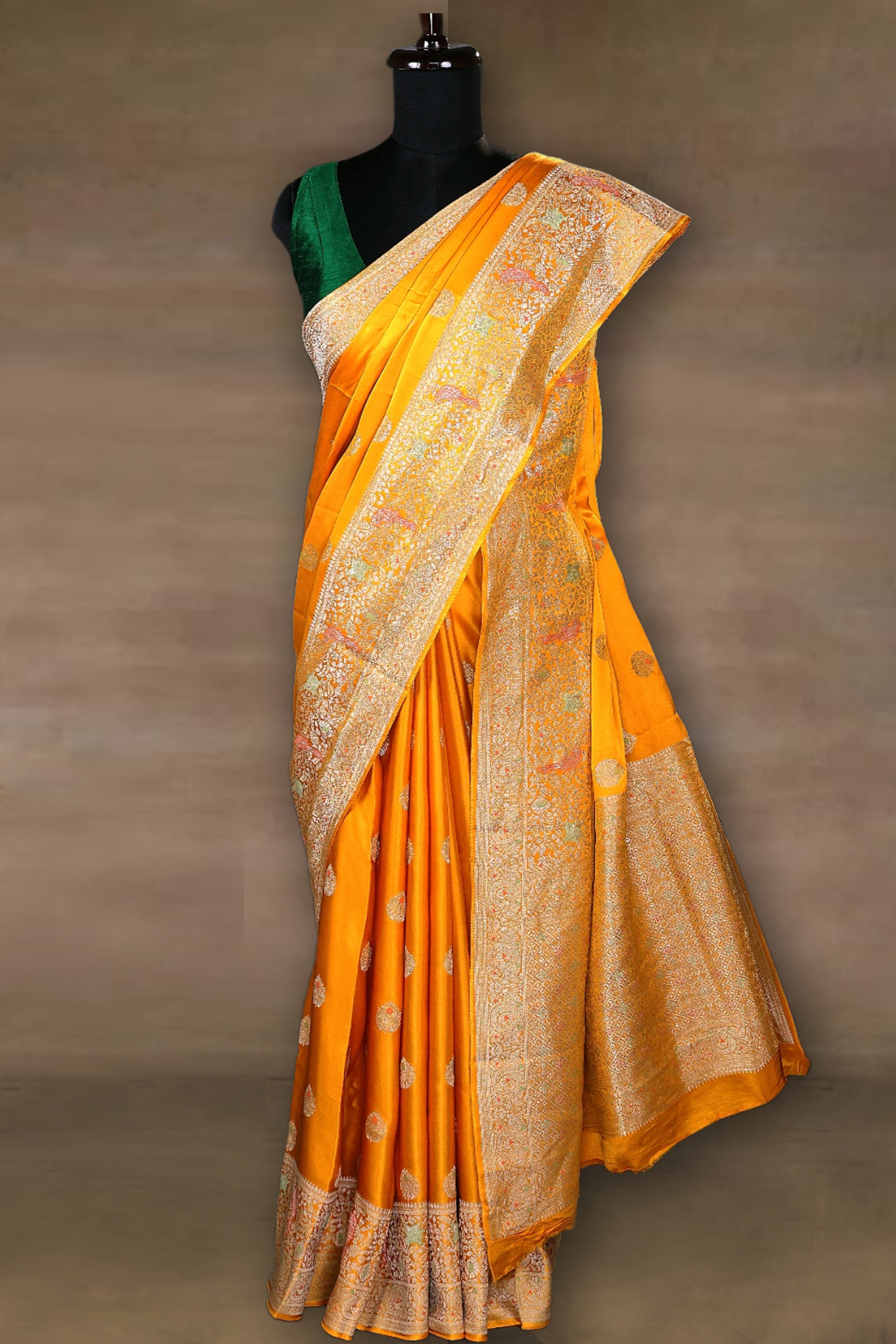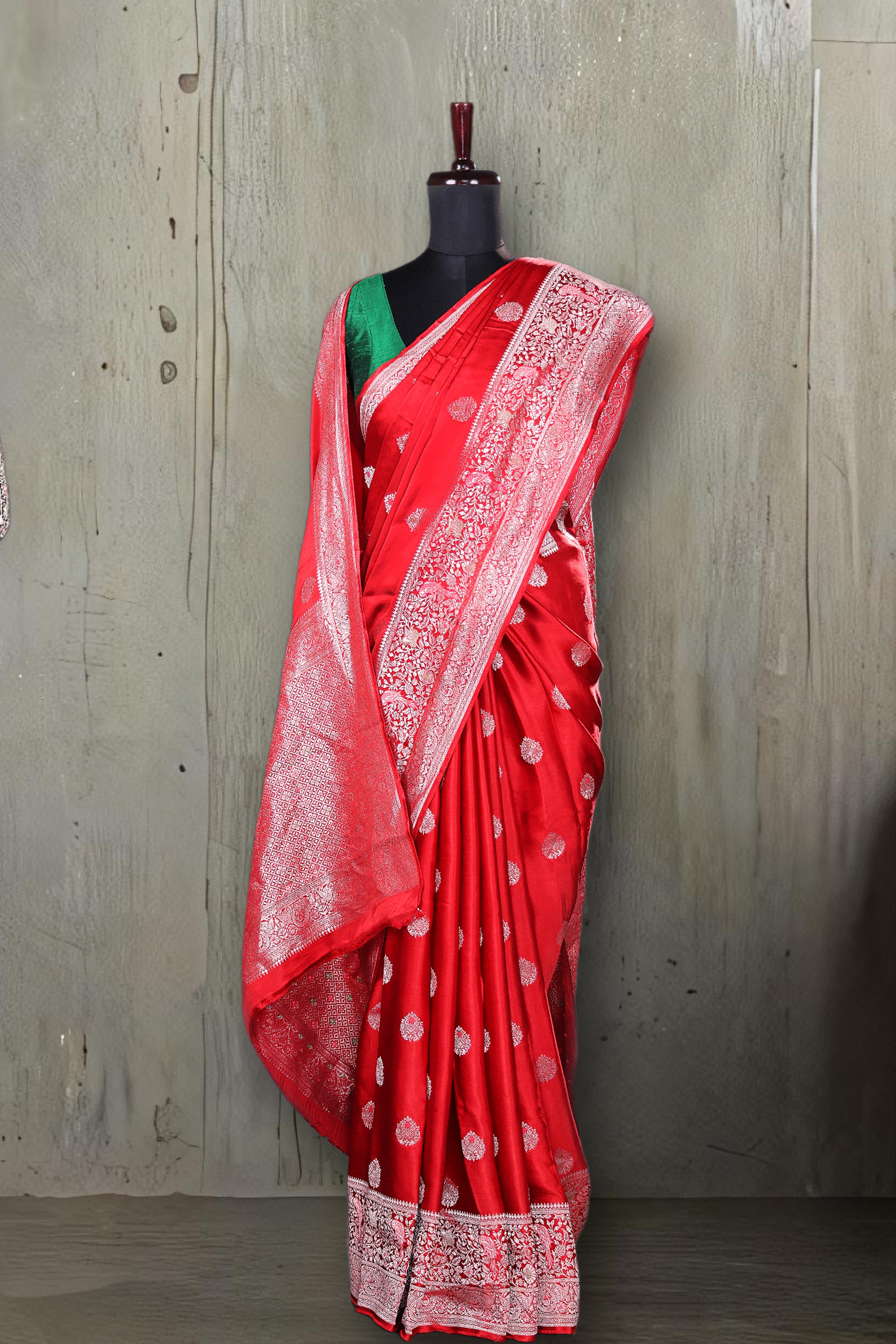A Semi Mashru Banarasi Saree combines the traditional Mashru fabric with the intricate weaving techniques of Banarasi craftsmanship. This unique fusion results in a saree that is both elegant and durable, making it a perfect choice for many occasions, from weddings to festivals. Let's break down what makes this saree style so special:
1. Mashru Fabric
-
Mashru is a type of fabric that blends silk and cotton. The word "Mashru" is derived from the Arabic word "mashru," which means "permissible" or "allowed" in the context of Islamic law (because the combination of silk and cotton was initially considered more appropriate for everyday wear).
- Historically, Mashru fabric was developed in Gujarat, but it has become popular in different parts of India, especially for making sarees and traditional garments.
-
Semi Mashru fabric is a variation of Mashru where the cotton content is higher, making it softer and more comfortable to wear, with a slightly reduced sheen compared to pure Mashru.
-
Semi Mashru Banarasi sarees incorporate the beauty and charm of traditional Banarasi weaving, including zari work (gold and silver threads), brocade patterns, and rich motifs, but in a more practical, wearable fabric.
2. Banarasi Weaving Style
- Banarasi sarees, famous for their intricate and luxurious weaving, come from Varanasi (Banaras), a city renowned for its silk weaving tradition.
-
Banarasi weaving involves the use of zari (gold or silver thread) to create intricate brocades, floral motifs, and paisley patterns. These elements are traditionally woven into the fabric using a jacquard loom, making the designs appear raised and ornate.
- The use of semi Mashru fabric in Banarasi sarees allows for lighter, more comfortable wear while still retaining the traditional look of Banarasi textiles.
3. Features of Semi Mashru Banarasi Sarees
-
Texture and Feel: The semi Mashru fabric has a soft, smooth texture that drapes well, with a subtle sheen. It is more breathable than pure silk, making it suitable for longer wear, especially during the daytime.
-
Zari Work: The semi Mashru Banarasi sarees still feature intricate zari work, though the metallic threadwork may be less heavy than that found in heavier, pure silk Banarasi sarees. This gives the saree a slightly more understated, yet elegant look.
-
Designs and Motifs: Like other Banarasi sarees, semi Mashru Banarasi sarees are often adorned with traditional designs, such as:
- Paisleys
- Floral motifs
- Geometric patterns
- Jangla (flowering vine) motifs
- Buti (small, repeated patterns)
4. Color Palette
-
Semi Mashru Banarasi sarees often come in rich, bold colors, similar to other Banarasi sarees, such as:
-
Red, Gold, Royal Blue, Emerald Green, Maroon, Pink, Black, and Purple.
- The cotton-silk blend gives the saree a more subtle luster, so colors appear slightly muted compared to the high shine of pure silk.
5. Occasions and Versatility
- Semi Mashru Banarasi sarees are ideal for a wide range of occasions. Their elegant yet comfortable fabric makes them suitable for:
-
Weddings (as a guest or even as a bride for a less heavy look)
-
Festivals (like Diwali, Durga Puja, or Navratri)
-
Formal events (like receptions, parties, or even office functions)
-
Daily wear (for special occasions when you want to wear something traditional but comfortable)
- Because the fabric is lighter than traditional Banarasi silk, it’s also more wearable for daytime events, making it a versatile addition to any wardrobe.
6. Care and Maintenance
- While Mashru fabric is relatively easier to maintain than pure silk, it still requires some care to preserve its texture and appearance:
-
Dry Cleaning: It's best to dry clean a Semi Mashru Banarasi saree to avoid damaging the zari work or the delicate fabric.
-
Storage: Store the saree in a cool, dry place. Avoid hanging it to prevent stretching. Wrapping it in a cotton or muslin cloth will keep it safe from dust and moisture.
7. Price Range
- Semi Mashru Banarasi sarees tend to be more affordable than pure silk Banarasi sarees due to the blend of materials (cotton and silk) used. However, the intricate zari work and craftsmanship still make them a premium option, and they can range from moderately priced to high-end, depending on the complexity of the design and the quality of the fabric.
8. Advantages of Semi Mashru Banarasi Sarees
-
Comfort: The blend of silk and cotton makes it much more breathable and comfortable, especially in warmer climates.
-
Practicality: While maintaining the traditional look of Banarasi textiles, the semi Mashru fabric is more practical for everyday use, offering a balance between elegance and ease.
-
Elegance without Heaviness: The lighter weight of the fabric makes it ideal for long-wearing occasions, without feeling too heavy or restrictive, unlike pure silk Banarasi sarees, which can sometimes feel bulky.
9. Modern Trends
- While traditional Banarasi weaving remains the core of these sarees, designers today are also blending contemporary colors, lighter textures, and even unique border patterns into Semi Mashru Banarasi sarees. These modern touches allow the saree to be both traditional and fashion-forward.
A Semi Mashru Banarasi Saree is perfect for someone who wants to experience the beauty and grandeur of a Banarasi saree but in a more comfortable, wearable fabric. Its blend of silk and cotton makes it both elegant and practical, allowing you to enjoy the opulence of Indian textiles without compromising on comfort.














